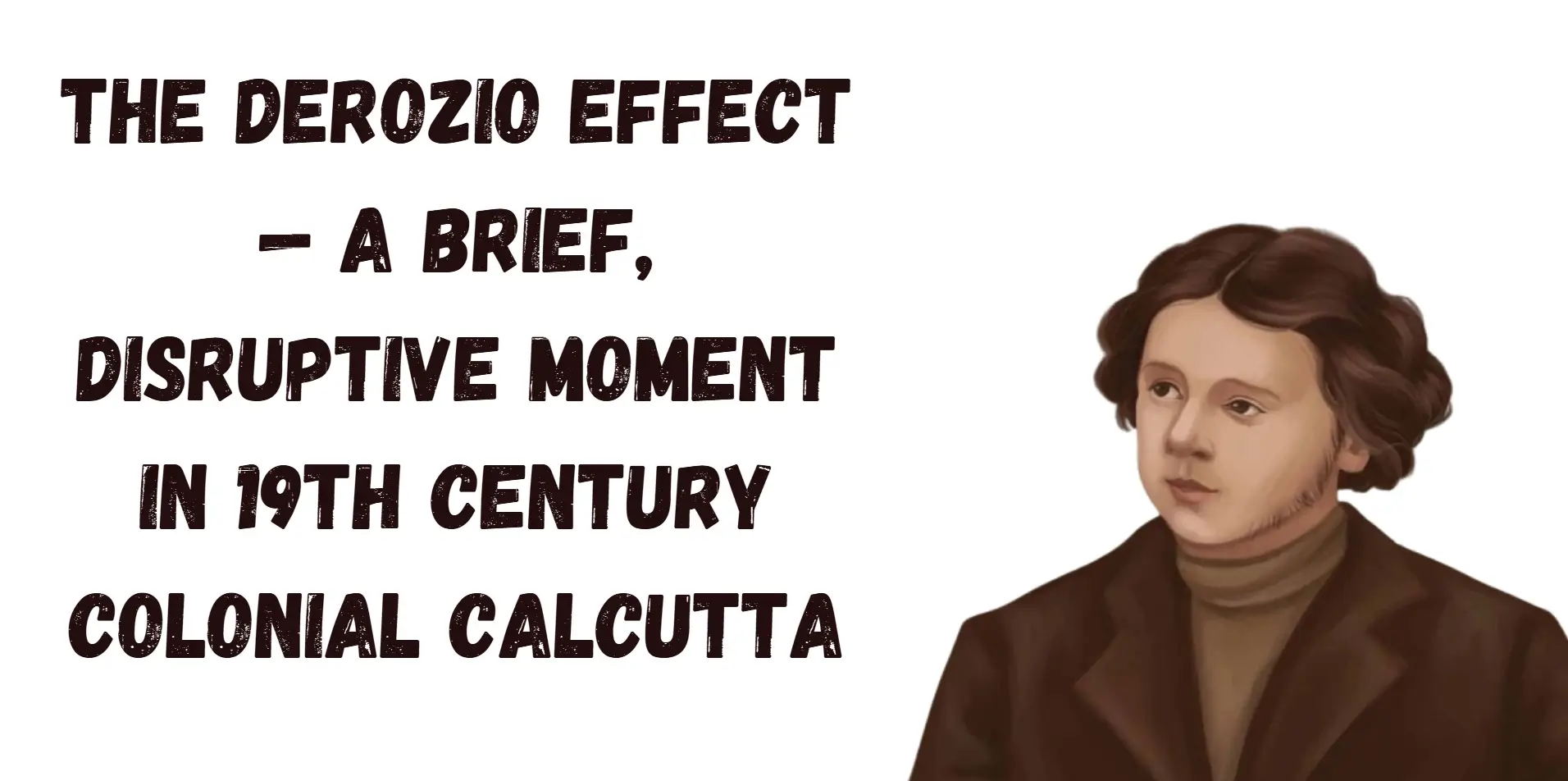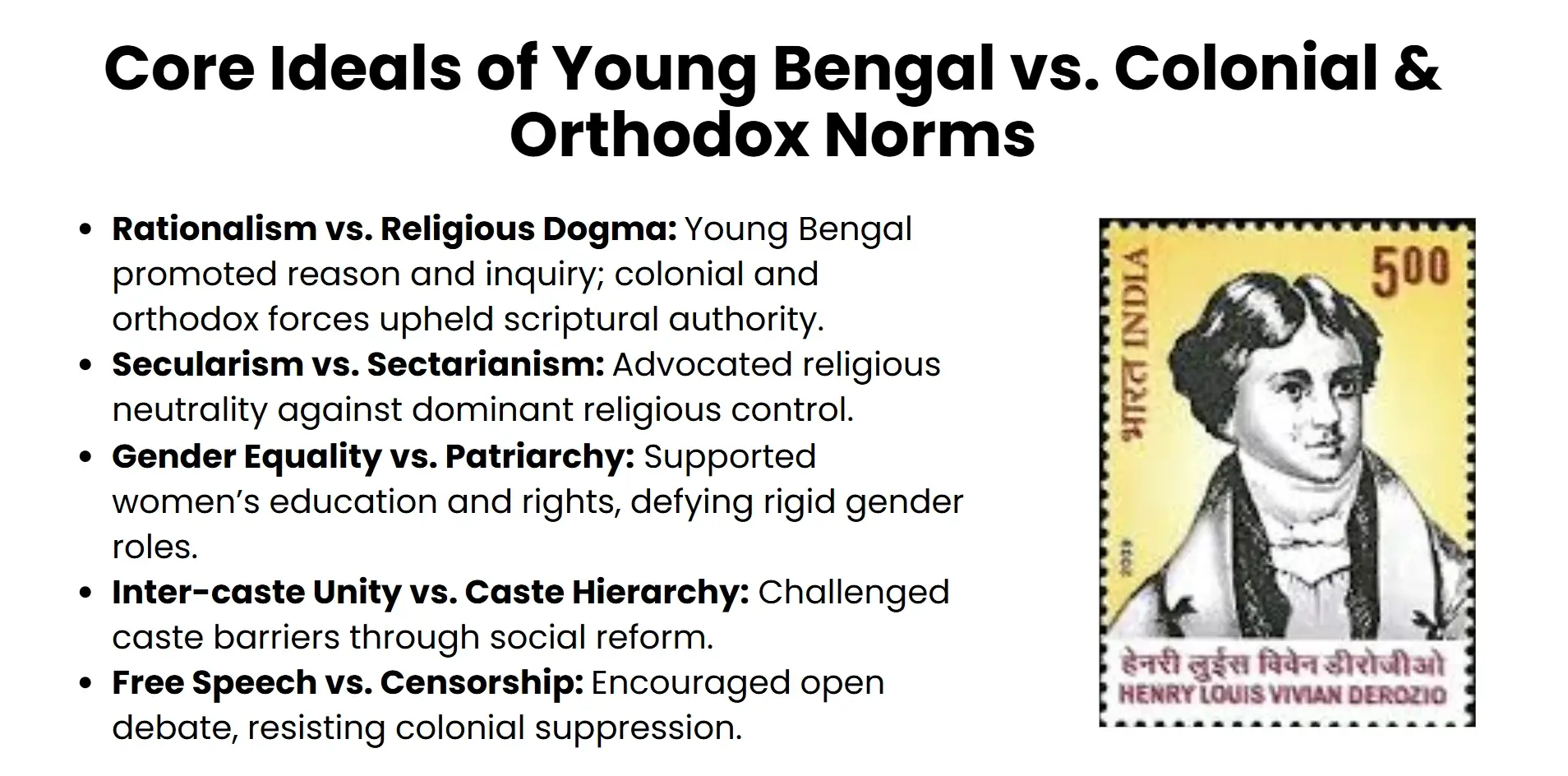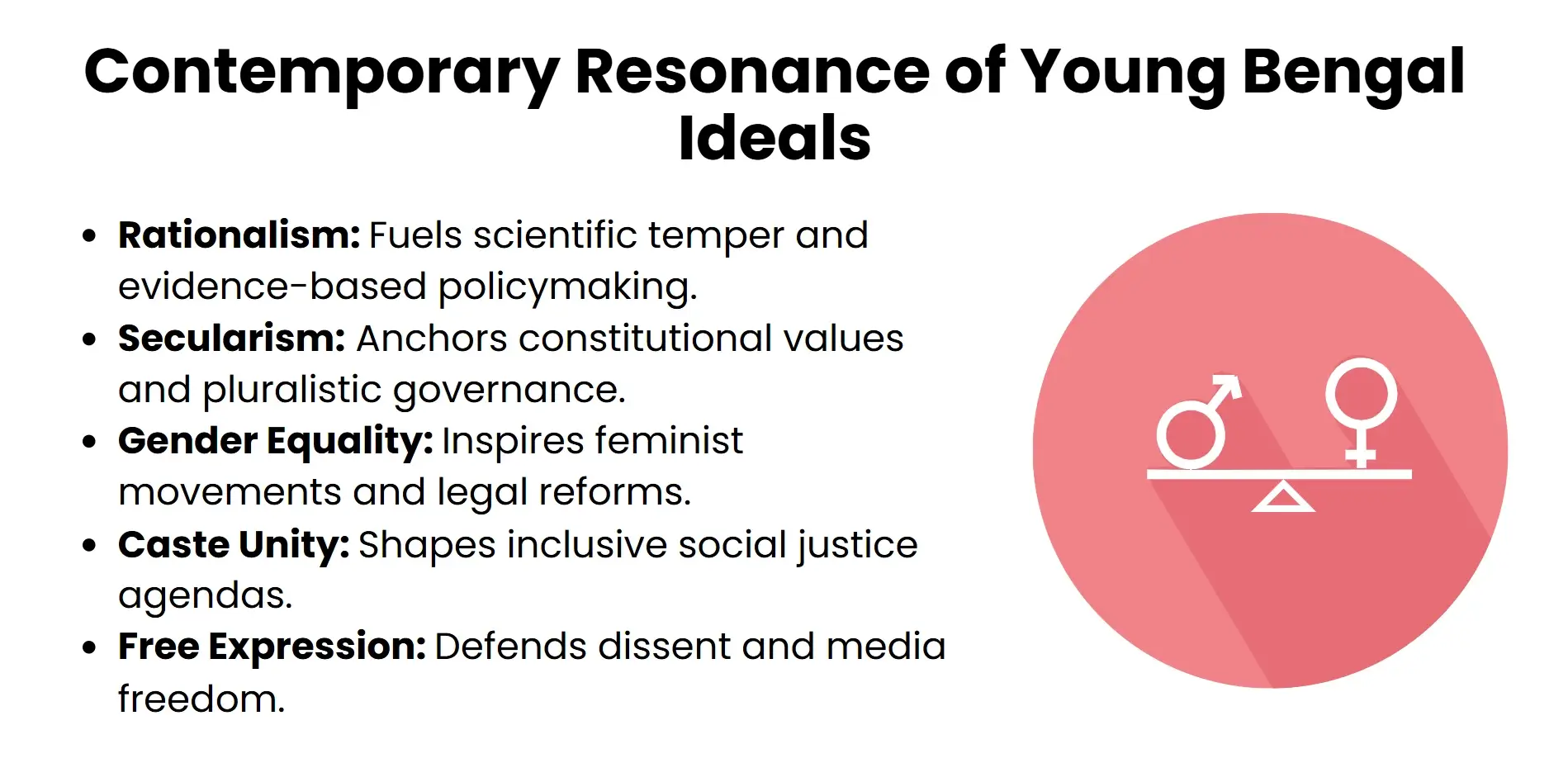The term "Derozio Effect" describes an important, if short-term, intellectual and social crisis that occurred in colonial Calcutta (modern-day Kolkata) in the 1820s and 1840s, mostly as a consequence of Henry Louis Vivian Derozio's teachings at the Hindu College.The article traces the origins of the first radical wave of reform in India that began with Derozio and Young Bengal in the colonial city of Calcutta and adopted a distinctly reformative discourse of reason and inclusivity, and of a secular vision.The Derozio effect. A brief, disruptive moment in 19th-century colonial Calcutta. Premium.

The early 19th-century Calcutta experienced an intellectual transformation, albeit of limited duration, which was led by Henry Louis Vivian Derozio, a poet, teacher and radical thinker at Hindu College. His pupils, the Young Bengal group, were radicals who shook vested orthodoxy and British complacency with a new radicalism, reason, secularism, and social amelioration, of a piece with the Wilsonian vision. Even though the movement was short-lived, its ideological meaning outlasted even its moment, providing a projection of the picture of an inclusive, tolerant, and intellectually stimulating India.Like the stuff of Enlightenment ideals and Romantic humanism, Derozio's pedagogy also promoted critical questioning and moral strength. His devotees discussed and argued caste, religion and colonial exploitation and set the foundations of reformist ideas that would be reiterated by Gandhi, Nehru and Tagore many years later. The Young Bengal movement, with the weaknesses of its elitist nature of the absence and mass mobilization, became the first radical opposition in India against its native conventionality and imperial dominance.This article revisits the Derozio effect not just as a historical afterthought, but as the point of inception of the Indian dream of building a nation based on pluralism, rationalityand unacceptable dissent. In so doing, it will raise the question of the everlasting potency of ideas to mould the nature of a society.
Calcutta Colonial and the Birth of Hindu College
Calcutta emerged as British India's administrative and intellectual hub at the start of the 1800s. Through the colonial change, Hindu College came to be born as a revolutionary change in Indian education and thought.
Calcutta: A Metropolitan Mirror in the Storm
In the 1810s, Calcutta had become a busy colonial capital, the place of residency of British colonialofficials and Bengali elites and an increasing number of urban professionals. The city was a pot of cultural diffusion where western ideasblended together with the local cultures. The colonial government aimed at cultivate a generation of Indians who would help them in governance, a need that required the innovation of educational institutions. This was also a time of native ambition; however, through the eyes of the reformist Indians, who could envisage that modern India would be based on knowledge and rationality.
Founding Hindu College: A Vision of Liberal Education
Hindu College was founded on 20 January 1817as a result ofa joint effort between progressive Indian philanthropistsand the East India Company. The college was pioneered by such persons as David Hare and Raja Ram Mohan Roy, with the aim of giving the sons of de respectable Hindu families a liberal education. It was not only a colonial tool rather it was an adventurous experiment in modernity and it combined Western curricula and Indian ambitions. It did not take the institution long before it was an abode of young intellectuals who were keen to explore philosophy, science, and political thinking.
Burning Ground of Radical ideas
The importance of Hindu College was not only found in its study routine, but in its ethos. It aroused skepticism, a sense of debate and questioning elements which in later years characterized the Young Bengal movement. The college was turned into a bastion of intellectual dissent as the college welcomed Henry Derozio as a teacher in 1826, who rebelled against both orthodoxy and colonialism.
Henry Derozio
During his brief life, Henry Louis Vivian Derozio (1809–1831), one of colonial Bengal's greatest luminaries, sparked a radical intellectual reawakening. Derozio was born to Indo-Portuguese parents in Calcutta and was strongly impacted by the Romantic poets Byron, Shelley, and Keats as well as the enlightenment ideas of progressive liberalism. His poetry, which combines lyrical grace and patriotism in pieces like To India - My Native Land and The Fakeer of Jungheera, can be considered the first expression of nationalism in English-language writing in India.
Even Derozio got employed there when he was only seventeen as a teacher in Hindu College and his radical teaching method turned the classroom into a furnace of discontent. He created an environment of fearless inquiry and taught students to question colonial power, the caste system, and religious orthodoxy. He had a charismatic method of teaching and his leanings towards reason, liberty and equality influenced a generation of students who were later referred to as the Young Bengal group.
Despite being expelled from the Hindu College in 1831 due to pressure from conservative elites on the educational system, Derozio left a lasting impression. He was not only a teacher or poet but actually an organizer of the first modern reformist movement in India. The ideals of secularism, rationalism, and inclusive nationalism that influenced the future of India still live on to this day in his legacy.
Young Bengal: First Radicals of India
During the turmoil of the 19th-century colonial Calcutta, an apolitical brigade of swashbuckling Hindu College (later Young Bengal) students appeared as the first radical reformers within India itself, defying the British as well as indigenous orthodoxy.

Intellectual Rebellion in Hindu College
Under the influence of their charismatic instructor Henry Derozio, these young men had been imbued with the ideas of the Enlightenment, reason,virtue and libertyin the foundation of a progressive social order and skepticism is the method of solid standing. In his classroom, Derozio created a dissenting crucible, and students argued about caste, religion, and colonial injustice. They were the founders of the Academic Association, a debating club that challenged established conventions and values, and advanced secular and egalitarian principles.
Profiles in Radicalism
Some of the daring thinkers in it were Radhanath Sikdar, Ramgopal Ghosh, Krishna Mohan Banerjee,andRasik Krishna Mallick. These students broke all social taboos by eating with members of different caste, procured widow remarriage and encouragingwomen's education, among other things. They shocked the conservative society but paved the pathfor future reformist activities.
Beyond Classroom: Political Awakening
Lacking mass mobilisation, Young Bengal made an impressive contribution to the formation of the discursive landscape. In 1843, members formed the Bengal British colonial rule in India Society, India's first political party, with the help of abolitionist George Thompson. Their books and sermons started expressing an ideal of an Indian nation based on justice, pluralism and intellectual liberty.
The Legacy and the Limitations
Young Bengal waned in its effect despite its zeal because of its urban elite orientation and social opposition. But their radicalism reverberated with the later reformers such as Vidyasagar and Surendranath Banerjee. They presented the earliest dream of an India of reason rather than dogma.
IDEOLOGICAL VISION: Inclusive, Tolerant and Eclectic
The Young Bengal, owing to their short historical existence, expressed a radical ideological vision on India; a vision that was inclusive, rational and pluralistic. Their thought is still vividly contemporary and extremely pertinent.
Reason above Orthodoxy
The religion or values engaged by Young Bengal was the feeling towards enlightenment values likeliberty, equality, and reason. They were affected by European liberalism and philosophers such as Bentham and Voltaire, and they did not want blind faith or discrimination on caste grounds. Their arguments at the Academic Association advocated empirical thinking, which ethically was secular and was directly in opposition to colonial patronizing and the orthodoxy of the natives.
Comprehensive and Eclectic Nationalism
Young Bengal was making their vision of an India that was not culturally narrow rather it was intellectually eclectic and socially inclusive. They did not welcome Western science and Western philosophy as a means of mimicry; they welcomed it as a means of liberation. None of this was a matter of religious or even ethnic identity but rather a matter of universally recognized human values.
Political Virtue of Tolerance
Tolerance as understood by the Derozians was not a passive acceptance of difference; rather, it had been mentioned as the active interaction with it. They promoted inter-caste food, education of women, and free expression i.e., things that went against social norms and the censorship practised by the British. Not anti-religious, their secularism offered a morally ordered world within the frames of reason and compassion.
Legacy in Modern Indian Thought
The movement died out towards the middle of the century, but its ideologicalmark remained. The inclusive spirit is continued by leaders such as Vidyasagar and Surendranath Banerjee, who acted as reformers. Young Bengal dreamed of India's early constitution with its values of liberty, equality, and fraternity, which were to be written many decades later.
Constraints and Criticisms
In spite of being intellectually progressive, the Young Bengal movement had great shortcomings that restricted its effectiveness in the long run. Among its more smashing inadequacies was its elitist compass. Within the urban English-educated society of the Hindu College, the movement never reached out to rural India or the other masses. Its radicalism e.g. inter-caste dining andsecularism, was so far off time to be appreciable in the highly conservative society.
As well, the movement had no depth in terms of organization. Derozio's dismissal and premature death in 1831 caused the group to break down. Their reformist enthusiasm thus evaporated despite the organized platform and continuity of leadership. Their intellectual focus on debate was innovative but did not manifest itself in institutional or grassroots action.
Another criticism made by the critics is that the Derozianswere enamoured with Western notions rather than being grounded in the indigenous realities. Their anti-traditionalist opinions were bold yet, in a way, verged on cultural alienation. This divide restricted their capacity for coalitions or achieving more social change.
Heritage and Modern Relevance
The Young Bengal movement did not last long, but its ideological traces still influence the Indian intellectual and the reformist trend. The Derozians were India’s first generation of modern radicals, establishing the foundations of a culture of contestation, secularism, and rational inquiry that repeated later during the Bengal renaissance and the nationalist vision.

By their unflinching probing of caste, religious orthodoxy and colonial rule, they inspired those reformers who followed their example, such as Ishwar Chandra Vidyasagar and Surendranath Banerjeeand took the light of social justice and liberal education. The movement's emphasis on civil liberties and critical thinking also preceded the principles of liberty, equality, and fraternity outlined in the Indian Constitution.
The Young Bengal legacy is echoed in arguments about free speech in contemporary India, secularism and the reform of education. Their ideals of an inclusiveand open-minded society still hold water in curbing the crest of majoritarianism and intellectual conformity. It is the audacity to rebel against transmitted dogma as witnessed with the students of Derozio, something with which activists, educators and intellectuals remain influenced who believe in pluralism and progress.
But the most powerful role that was played by Young Bengal was notinstitutional but ideological, a pattern of reform based on reason, supersensualcompassion and fearless confrontation with the world. Their heritage provides a reminder that radical thinking, even when fringe, can influence the spirit of a nation.
Conclusion
Although short-lived, the Derozio-ledYoung Bengalmarked a significant paradigm shift in the intellectual history of India. In a world of colonial super-ordination and cultural moral strictness, these innocent young vigilantes dared to think that the nation should be made possible throughreason, parity, and uninhibited questioning. Their diverse, accommodating, and morally upright outlook predicted the future pluralism and secularism of the Indian constitution-making process.They had a brief and limited impact, but some of the ideological ground they established has endured. One can trace the shadows of the radical spirit of Young Bengal in social reforms initiated by Vidyasagar, the scientific temper of Nehru, and the moral pluralism of Gandhi through the generations. More than a piece of history, the Derozio effect is a living reminder that ground-breaking ideas tend to start with an alarmand that resistance, when based on both compassion and intellect. Their heritage lives on in the challenges to protect reason, tolerance,and broad-based progress.